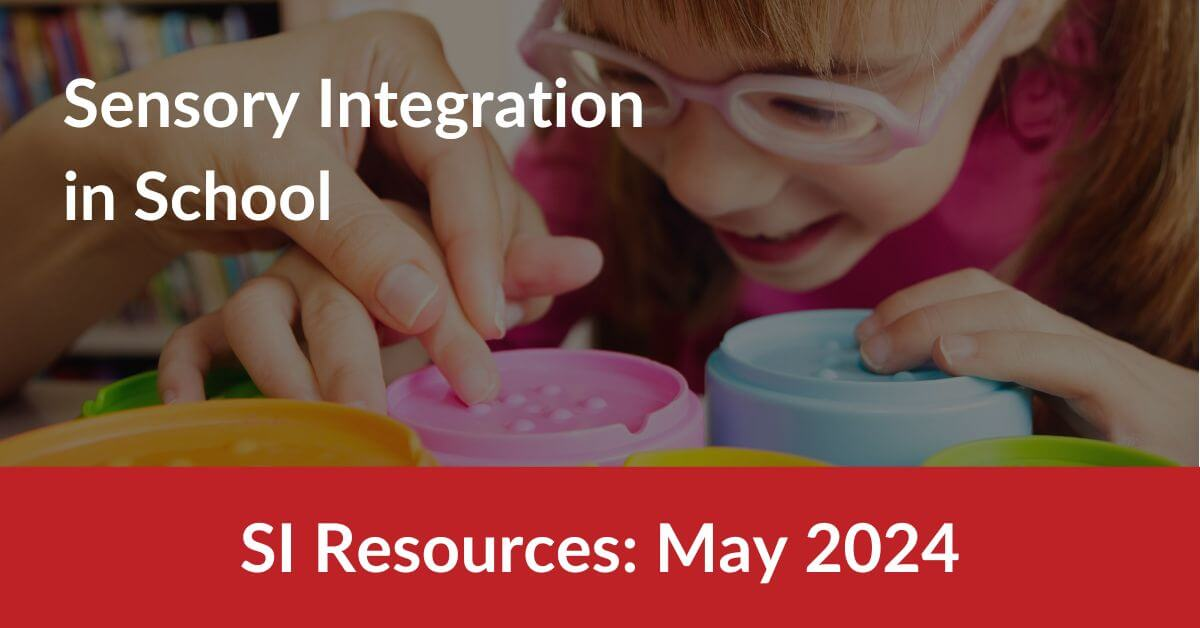SI Resources May 2024: Sensory Integration in Schools
By Sensory Integration Education, 26 April 2024

This month's SI Resources blog is focused on sensory integration in schools.
Challenges in processing sensory information can significantly impact a child’s educational experience. With 1 in 6 children having sensory processing differences that make it hard to learn and function in school, it’s likely there are undetected and unsupported sensory needs in many classrooms.
In this month’s blog, we’ve curated articles, guides, books and products to help better inform ourselves of how sensory integration affects students and its impact on their behaviour and learning as well as insights and strategies for supporting students’ sensory needs and making schools a more sensory inclusive environment.

Occupational Therapy in Schools - In school-based OT, occupational therapists look to support students in their education. This may involve supporting fine motor, visual motor, visual perceptual, sensory motor, executive functioning skills, cognitive skills, physical skills or other areas which impact the students' ability to learn. This article from The OT Toolbox looks at strategies school-based OT practitioners can use in the classroom, in small groups, or in one-to-one sessions.
Sensory Rooms in Schools - Another useful article from The OT Toolbox that explores the benefits of sensory rooms in schools. Sensory rooms are spaces in schools that offer a sensory break for those who enter. A school sensory room might be an empty classroom that has been transformed into a space with sensory tools and is used as a movement break for students.
Classroom Accommodations for Sensory Processing Challenges - Students with sensory processing challenges have trouble managing everything their senses are taking in. At school, they often have to cope with sounds, smells, textures, and other sensations that get in the way of learning. This blog from Understood highlights classroom accommodations schools can try to help students who have difficulties processing sensory information.
A Collaborative Approach to Developing Communication: A Case Study - At Oaklands Special School in Leicester, all their pupils have speech, language and communication as their primary special educational need. Therefore Communication, Interaction & Social Skills (CISS) are at the heart of everything the school does to support their pupils’ development. This case study published by the National Autistic Society looks at how Oaklands has worked together with parents and speech and language therapists to utilise and develop communication strategies and details the impact this has had on one of their students, Ethan.
All the Feelings, All the Time - ADHD seems to exacerbate and exaggerate everything — especially our senses. This article from ADDitude looks at common ADHD hypersensitivities and expert recommendations on how to manage them.
How Sensory Processing Issues Affect Kids in School - Sensory processing issues can make it hard for children to succeed at school. For example, sensitive kids might be overwhelmed by bright lights or loud noises or they might have trouble paying attention because their clothing is uncomfortable. Under-sensitive kids might be fidgety and unable to sit still. They might get into trouble for seeking stimulation by bumping, jumping or crashing into other kids. This article looks at what parents and teachers can do to help children with sensory processing issues in the classroom.
Strategies for Supporting Individuals with Autism in Educational Settings (Autism in Schools) - According to Beyond Autism, autism is three times more prevalent in boys than girls and 31.3% of pupils with an Education and Health Care Plan (EHCP) in the UK have autism listed as their primary type of need. That works out to approximately 103,400 pupils and it's the most common type of need listed among EHCPs in the UK. This article from CPD Online College looks at strategies for supporting autistic children and young people in schools.
Books and Product Ideas








